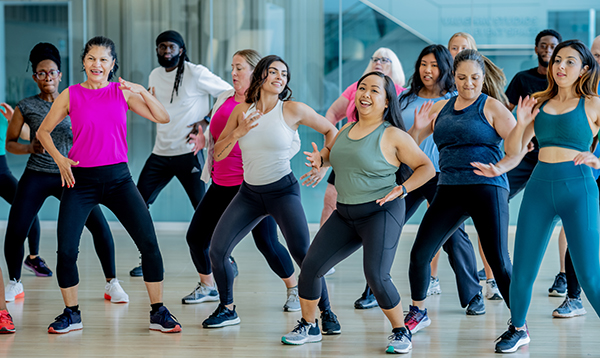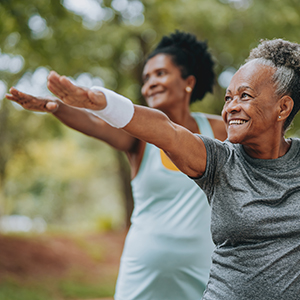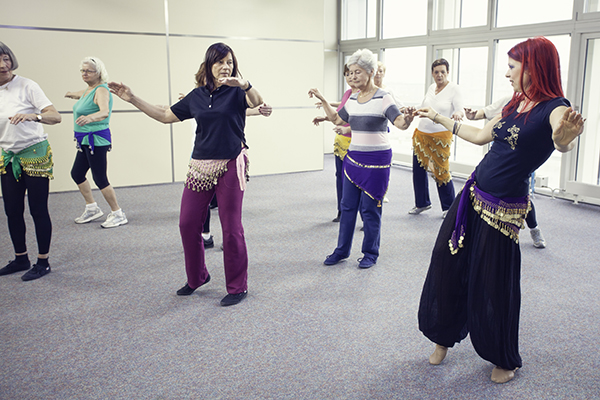Dance-Based Fitness Classes
Get tips for enjoying a great workout and keeping fitness fun with specialty dance classes like Zumba.
By Mary Jo DiLonardo | Updated July 3, 2024
Sometimes just getting out of bed and making it through the day with arthritis may feel like all you can manage. But your rheumatologist may recommend that you try to be more active. If other types of aerobic exercise aren’t appealing, you may want to try a dance-based fitness class like Zumba, a high-energy Latin dance fitness class.
“Everyone suggested swimming, but this sounded more fun,” says Tammy Rivera-Tubbs, who was diagnosed with rheumatoid arthritis (RA) when she was 42. The idea of an energetic dance class inspired her to move. “My arthritis is better for me in some ways. It gives me something to look forward to, which gives me energy,” says Rivera-Tubbs, who writes a blog about living with rheumatoid arthritis. “I feel great because I focus on something that is positive instead of that my ankles or knees are hurting.”
Benefits of Dance Fitness
 Zumba is just one of the many specialized fitness dance programs gaining new followers, thanks in part to the exposure of exotic dance styles on television shows such as “Dancing with the Stars” and “So You Think You Can Dance.” The classes, including belly dancing, hip-hop, Bollywood and even pole dancing, can help increase coordination, balance and cardiovascular levels, as long as they’re done with some modifications for people with arthritis.
Zumba is just one of the many specialized fitness dance programs gaining new followers, thanks in part to the exposure of exotic dance styles on television shows such as “Dancing with the Stars” and “So You Think You Can Dance.” The classes, including belly dancing, hip-hop, Bollywood and even pole dancing, can help increase coordination, balance and cardiovascular levels, as long as they’re done with some modifications for people with arthritis.Dancing also can help keep people interested in exercise, says Steffany Moonaz, PhD, a dancer/choreographer, public health scientist and founder of Yoga For Arthritis in Baltimore. “Dance is a mind/body activity because you have to be engaged in what you’re doing. You can’t zone out or you will step on your toes or someone else’s toes,” says Moonaz. “There are a lot of benefits to staying active in an engaging mind/body way, especially for people with arthritis.”
In several studies, for example, researchers at Laval University in Quebec followed people with rheumatoid arthritis who participated in dance-based exercise. They found improvement in mobility and joint pain, as well as positive changes in depression, anxiety, fatigue and tension.

Manage Your Weight for Arthritis
Types of Dance Fitness
Here’s a look at some of the more popular dance fitness trends with tips from American Council on Exercise-certified personal trainer and fitness instructor, Jessica Matthews, on how to modify the classes if you have arthritis.
Zumba. This Latin-inspired, salsa-type class features upbeat music and a fast tempo. The motions include lots of hip action and shimmying. Look for Zumba Gold classes, which are geared toward beginners, people who may have some physical limitations, and older adults. If Zumba Gold isn’t an option, slow down the pace or motions in a regular Zumba class, but keep moving.
 Belly Dancing. Inspired by dance styles from places such as Egypt, Morocco and Turkey, this slow, rhythmic dance is great for people with arthritis because the movements are slow and isolated, and done with both feet flat on the floor. With actions such as hip circles and shoulder shimmies, belly dancing can help increase range of motion, says Matthews, but be aware that it takes time to gradually progress to those kinds of movements.
Belly Dancing. Inspired by dance styles from places such as Egypt, Morocco and Turkey, this slow, rhythmic dance is great for people with arthritis because the movements are slow and isolated, and done with both feet flat on the floor. With actions such as hip circles and shoulder shimmies, belly dancing can help increase range of motion, says Matthews, but be aware that it takes time to gradually progress to those kinds of movements.
Hip-Hop. The music and the movements of this street-based dance are very upbeat and lively with high-intensity, high-impact steps where dancers quickly transfer their weight from one foot to another. With arthritis, you need to avoid those rapid movements, stepping instead of jumping and keeping both feet on the floor.
Bollywood. With roots in the Hindi movies in India, Bollywood dancing involves bouncing and side-to-side movements. Like hip-hop, it can also be high impact with leaps as dancers keep pace with the fast-tempo music. The key for people with arthritis, says Matthews, is to step instead of jump, keeping movements low-impact, and find a comfortable and safe tempo.
Pole Dancing. Sensual yet fun, pole dancing can be an unusual way to build muscle strength, flexibility and confidence. Using a pole as a prop involves a great deal of upper body strength and a lot of hand gripping so the exercise may be totally off-limits for anyone with serious hand or wrist issues. There’s also a lot of twisting in the knees and hips, so be very aware of your movements.
Always consult your physician or physical therapist before trying a new fitness regime, such as one of these dance styles. Matthews also offers some general tips to keep in mind.
Tips for Dance Fitness
Start slowly. Don’t jump into any exercise full-throttle or you’ll pay for it the next morning and beyond.
Slow down the pace. Do the dance moves in half time and avoid repetitive movements. This will help prevent injury and straining joints.
Approach the instructor. When you sign up, tell her about any issues or limitations so she can provide modifications.
Check with your doctor. Before you start any exercise, get your doctor or physical therapist’s opinion. She may be able to recommend one type of exercise over another and provide additional modifications suited for you.

Stay in the Know. Live in the Yes.
Get involved with the arthritis community. Tell us a little about yourself and, based on your interests, you’ll receive emails packed with the latest information and resources to live your best life and connect with others.
